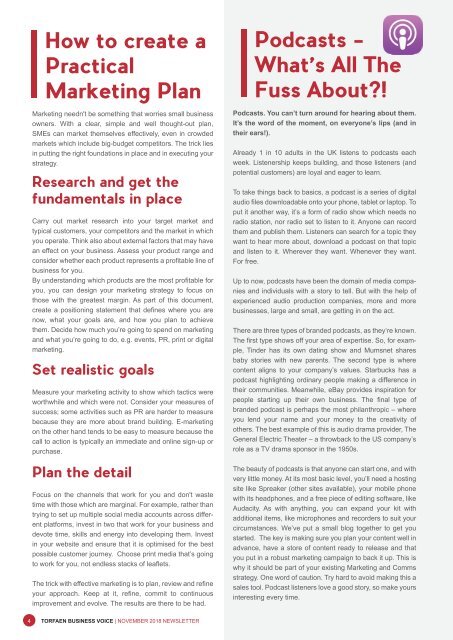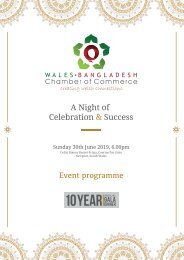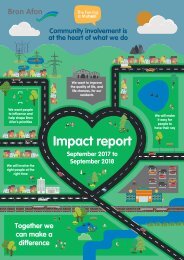TBV Newsletter December 2018 (Full)
Create successful ePaper yourself
Turn your PDF publications into a flip-book with our unique Google optimized e-Paper software.
How to create a<br />
Practical<br />
Marketing Plan<br />
Marketing needn't be something that worries small business<br />
owners. With a clear, simple and well thought-out plan,<br />
SMEs can market themselves effectively, even in crowded<br />
markets which include big-budget competitors. The trick lies<br />
in putting the right foundations in place and in executing your<br />
strategy.<br />
Research and get the<br />
fundamentals in place<br />
Carry out market research into your target market and<br />
typical customers, your competitors and the market in which<br />
you operate. Think also about external factors that may have<br />
an effect on your business. Assess your product range and<br />
consider whether each product represents a profitable line of<br />
business for you.<br />
By understanding which products are the most profitable for<br />
you, you can design your marketing strategy to focus on<br />
those with the greatest margin. As part of this document,<br />
create a positioning statement that defines where you are<br />
now, what your goals are, and how you plan to achieve<br />
them. Decide how much you’re going to spend on marketing<br />
and what you’re going to do, e.g. events, PR, print or digital<br />
marketing.<br />
Set realistic goals<br />
Measure your marketing activity to show which tactics were<br />
worthwhile and which were not. Consider your measures of<br />
success; some activities such as PR are harder to measure<br />
because they are more about brand building. E-marketing<br />
on the other hand tends to be easy to measure because the<br />
call to action is typically an immediate and online sign-up or<br />
purchase.<br />
Plan the detail<br />
Focus on the channels that work for you and don't waste<br />
time with those which are marginal. For example, rather than<br />
trying to set up multiple social media accounts across different<br />
platforms, invest in two that work for your business and<br />
devote time, skills and energy into developing them. Invest<br />
in your website and ensure that it is optimised for the best<br />
possible customer journey. Choose print media that’s going<br />
to work for you, not endless stacks of leaflets.<br />
The trick with effective marketing is to plan, review and refine<br />
your approach. Keep at it, refine, commit to continuous<br />
improvement and evolve. The results are there to be had.<br />
Podcasts -<br />
What’s All The<br />
Fuss About?!<br />
Podcasts. You can’t turn around for hearing about them.<br />
It’s the word of the moment, on everyone’s lips (and in<br />
their ears!).<br />
Already 1 in 10 adults in the UK listens to podcasts each<br />
week. Listenership keeps building, and those listeners (and<br />
potential customers) are loyal and eager to learn.<br />
To take things back to basics, a podcast is a series of digital<br />
audio files downloadable onto your phone, tablet or laptop. To<br />
put it another way, it’s a form of radio show which needs no<br />
radio station, nor radio set to listen to it. Anyone can record<br />
them and publish them. Listeners can search for a topic they<br />
want to hear more about, download a podcast on that topic<br />
and listen to it. Wherever they want. Whenever they want.<br />
For free.<br />
Up to now, podcasts have been the domain of media companies<br />
and individuals with a story to tell. But with the help of<br />
experienced audio production companies, more and more<br />
businesses, large and small, are getting in on the act.<br />
There are three types of branded podcasts, as they‘re known.<br />
The first type shows off your area of expertise. So, for example,<br />
Tinder has its own dating show and Mumsnet shares<br />
baby stories with new parents. The second type is where<br />
content aligns to your company’s values. Starbucks has a<br />
podcast highlighting ordinary people making a difference in<br />
their communities. Meanwhile, eBay provides inspiration for<br />
people starting up their own business. The final type of<br />
branded podcast is perhaps the most philanthropic – where<br />
you lend your name and your money to the creativity of<br />
others. The best example of this is audio drama provider, The<br />
General Electric Theater – a throwback to the US company’s<br />
role as a TV drama sponsor in the 1950s.<br />
The beauty of podcasts is that anyone can start one, and with<br />
very little money. At its most basic level, you’ll need a hosting<br />
site like Spreaker (other sites available), your mobile phone<br />
with its headphones, and a free piece of editing software, like<br />
Audacity. As with anything, you can expand your kit with<br />
additional items, like microphones and recorders to suit your<br />
circumstances. We’ve put a small blog together to get you<br />
started. The key is making sure you plan your content well in<br />
advance, have a store of content ready to release and that<br />
you put in a robust marketing campaign to back it up. This is<br />
why it should be part of your existing Marketing and Comms<br />
strategy. One word of caution. Try hard to avoid making this a<br />
sales tool. Podcast listeners love a good story, so make yours<br />
interesting every time.<br />
4<br />
TORFAEN BUSINESS VOICE | NOVEMBER <strong>2018</strong> NEWSLETTER

















